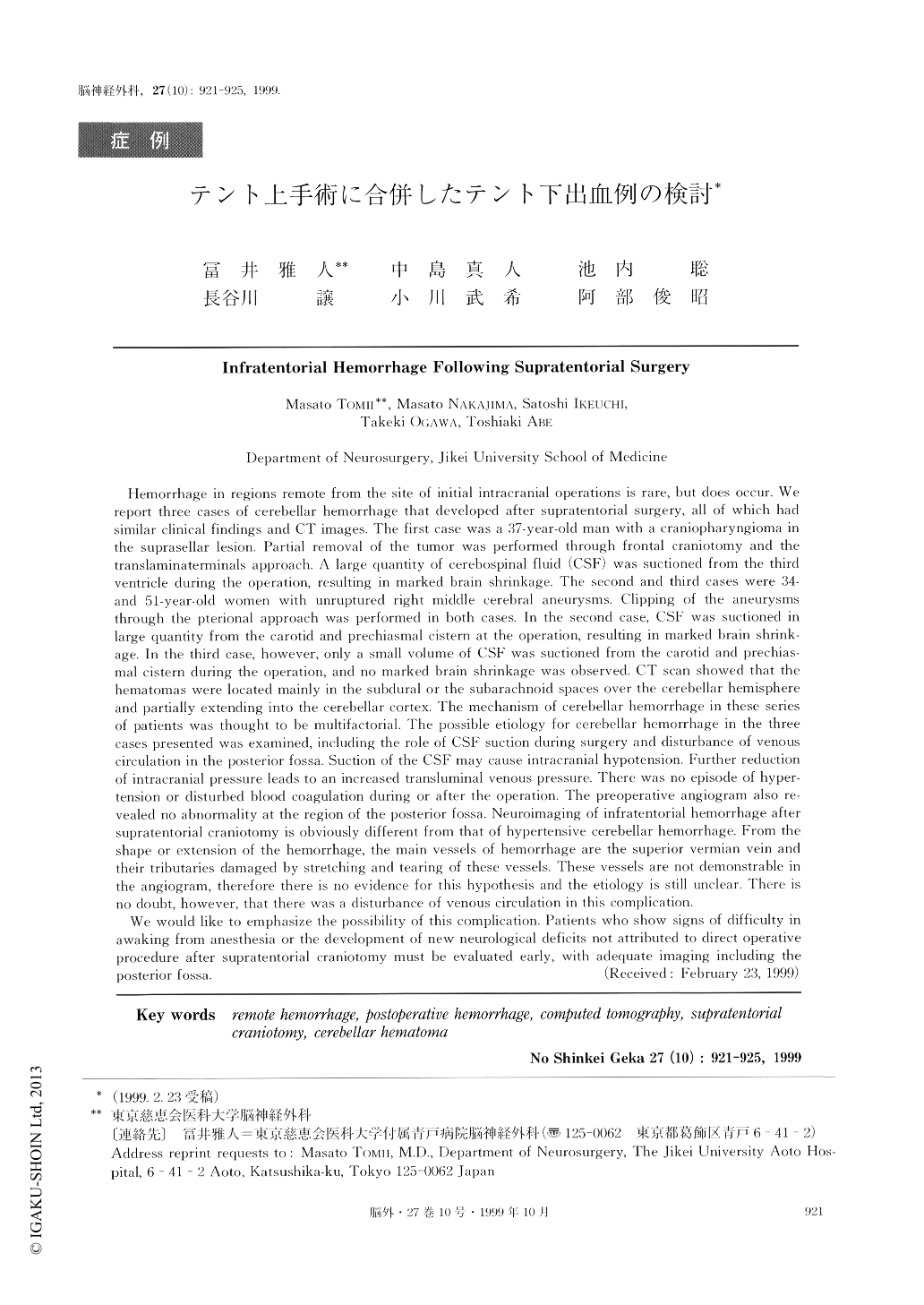Japanese
English
- 有料閲覧
- Abstract 文献概要
- 1ページ目 Look Inside
I.はじめに
脳神経外科手術の最も忌むべき合併症の一つとして術後出血がある.このうち手術野もしくはその近傍に発生するものは合理的理由が考慮されるが,術野から遠隔部に発生するものについては明確な理由が見当たらない.
今回われわれは,テント上手術に合併してテント下出血を発生した3症例を経験したので発生機序に対する考察を中心に報告する.
Hemorrhage in regions remote from the site of initial intracranial operations is rare, but does occur. Wereport three cases of cerebellar hemorrhage that developed after supratentorial surgery, all of which hadsimilar clinical findings and CT images. The first case was a :37-year-old man with a craniopharyngioma inthe suprasellar lesion. Partial removal of the tumor was performed through frontal craniotomy and thetranslaminaterminals approach. A large quantity of cerebospinal fluid (CSF) was suctioned from the thirdventricle during the operation, resulting in marked brain shrinkage. The second and third cases were 34-and 51-year-old women with unruptured right middle cerebral aneurysms. Clipping of the aneurysmsthrough the pterional approach was performed in both cases. In the second case, CSF was suctioned inlarge quantity from the carotid and prechiasmal cistern at the operation, resulting in marked brain shrink-age. In the third case, however, only a small volume of CSF was suctioned from the carotid and prechias-mal cistern during the operation, and no marked brain shrinkage was observed. CT scan showed that thehematomas were located mainly in the subdural or the subarachnoid spaces over the cerebellar hemisphereand partially extending into the cerebellar cortex. The mechanism of cerebellar hemorrhage in these seriesof patients was thought to be multifactorial. The possible etiology for cerebellar hemorrhage in the threecases presented was examined, including the role of CSF suction during surgery and disturbance of venouscirculation in the posterior fossa. Suction of the CSF may cause intracranial hypotension. Further reductionof intracranial pressure leads to an increased transluminal venous pressure. There was no episode of hyper-tension or disturbed blood coagulation during or after the operation. The preoperative angiogram also re-vealed no abnormality at the region of the posterior fossa. Neuroimaging of infratentorial hemorrhage aftersupratentorial craniotomy is obviously different from that of hypertensive cerebellar hemorrhage. From theshape or extension of the hemorrhage, the main vessels of hemorrhage are the superior vermian vein andtheir tributaries damaged by stretching and tearing of these vessels. These vessels are not demonstrable inthe angiogram, therefore there is no evidence for this hypothesis and the etiology is still unclear. There isno doubt, however, that there was a disturbance of venous circulation in this complication.
We would like to emphasize the possibility of this complication. Patients who show signs of difficulty inawaking from anesthesia or the development of new neurological deficits not attributed to direct operativeprocedure after supratentorial craniotomy must he evaluated early, with adequate imaging including theposterior fossa.

Copyright © 1999, Igaku-Shoin Ltd. All rights reserved.


